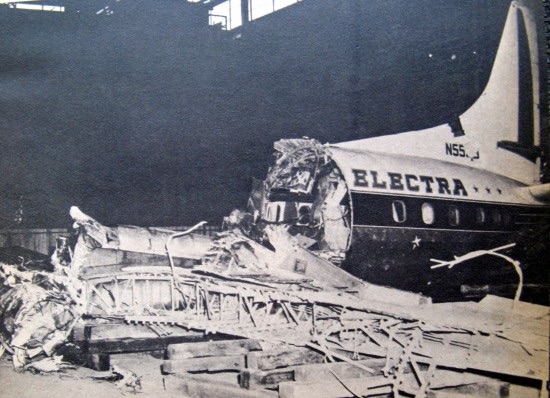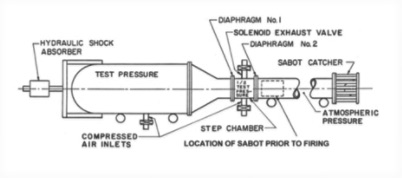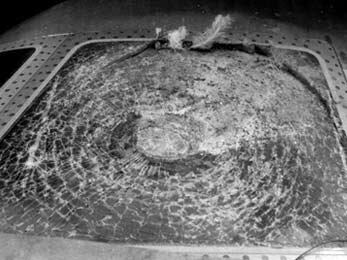16 March 1978
The Americans, the Russians, and now apparently the North Koreans, have their ICBMs, the British their Trident submarines, and the French their force de dissuasion. What does Canada have? We have, or rather had, the chicken cannon. Although fodder for many jokes on the Royal Canadian Air Farce, this piece of Canadian weaponry did more practical good than all the nuclear arsenals of the world. More accurately called the “flight impact simulator,” the chicken cannon, or bird gun, was used at Ottawa’s Macdonald-Cartier Airport from 1968 to 2009 to certify airplane windshields, engines and other aircraft parts against bird strikes.
Collisions with birds represent a serious threat to airplanes, particularly during take-offs and landings when planes traverse avian airspace. (Canada geese have, however, been encountered at 30,000 feet.) A bird striking an airplane in flight has what is known as kinetic energy (E) that is directly proportional to its mass (M) and to the square of its velocity (V). (The formula is E=1/2MV².) Consequently, even a small bird, can do significant damage, including shattering an airplane’s windshield and killing the pilot. Flocks of birds can cause multiple strikes, and if they are sucked into an airplane’s turbines, can lead to catastrophic engine failure.
Birds have collided with airplanes since the dawn of aviation. Particularly problematic are gulls, accounting for roughly half of recorded bird incidents. Orville Wright apparently experienced a bird strike in 1905. Aviation pioneer Cal Rodgers was the first person’s whose death was caused by a bird strike when a gull downed his airplane over the Pacific Ocean near the coast of California in 1912. But research into bird strikes on airplanes didn’t really get going until the early 1950s. In part, this reflected the fact that bird strikes were a fairly rare phenomenon during the early years of flying. Airplanes were small and relatively slow. As well, piston-driven airplane engines are less susceptible to damage from bird strikes that turbine engines with axial-flow compressors such as those used by modern jets and turbo-prop airplanes.
Today, global statistics on bird strikes are hard to come by as many countries don’t collect statistics on plane-bird interactions. Also, many strikes are unreported since they either caused no damage or go unnoticed. However, by one estimate, a bird strike occurs once in every 2,000 flights. Consequently, the odds that any particular flight will experience a bird strike are small. But as there are more than 100,000 aircraft flights every day in the world, this means on average there are at least 50 bird strikes per day. According to the Federal Aviation Administration (FAA), there were 13,688 airplane strikes with wildlife in 2014 in the United States, of which almost 97 per cent were represented by birds, with the remainder accounted for by terrestrial animals, bats, and reptiles. (The terrestrial animals and reptiles were hit while the airplanes were taxiing—no flying pigs or pterodactyls. In Australia, there have been kangaroo strikes.) Fortunately, most collisions with wildlife do not lead to human fatalities. FAA statistics show that in the twenty years to end 2013, only twenty-five people died from aircraft collisions with wildlife in the United States, with another 279 injured. In Canada, there have been only two known airplane crashes due to bird strikes that caused human deaths. In 1971, three people died when a Cessna 180 hit a bald eagle in British Columbia. In 1976, a military training jet, a CT-114 Tutor, was also downed by birds near Regina causing the death of its two crewmen.
 Chicken Cannon, Electra Accident 1960. The Eastern Airlines Lockheed Electra aircraft brought down by a flock of starlings, Boston, 4 October 1960
Chicken Cannon, Electra Accident 1960. The Eastern Airlines Lockheed Electra aircraft brought down by a flock of starlings, Boston, 4 October 1960
Aviation Saftey NetworkBesides the loss of life, bird strikes are costly for airlines. Repairing and replacing damaged equipment is estimated to cost as much as US$1.25 billion per year. Added to these direct costs are the costs of prevention, deterrence, and liability paid for by airlines, airline manufacturers, and airports.
Airplane manufacturers began using gas-operated bird cannons to test aircraft windshields during the 1950s. The earliest-known chicken gun was built by de Havilland in England. Canada got into the business during the 1960s following two serious incidents in the United States. In early October 1960, a Lockheed Electra owned by Eastern Airlines struck a flock of starlings shortly after take-off from Boston Logan Airport to Philadelphia. Birds were ingested in three of its four engines causing engine failure and the aircraft to crash. Sixty-two of the seventy-five people on board perished. Two years later, a Vickers Viscount owned by United Airlines en route from Newark, New Jersey to Washington D.C.’s National Airport met a flock of whistling swans flying at 6,000 feet. One or more birds hit the airplane’s left horizontal stabilizer sending the aircraft out of control. All seventeen people on board died.
In light of these accidents, Transport Canada asked the National Research Council (NRC) to establish a committee to look at the problem. A multi-prong approach was taken—prevention, research and testing, certification of aircraft, and bird-proofing. The committee, called the Associate Committee on Bird Hazards to Aircraft, involved Transport Canada, the Department of National Defence, the Canadian Wildlife Service, the major Canadian airlines, aircraft manufacturers, pilots, and NRC aircraft experts.
As part of its research efforts to certify aircraft against bird strikes, the Committee examined a number of methods of “delivering” a bird to its research target before choosing a cannon powered by compressed gas. Alternatives included a steam catapult like those used to launch V1 (Buzz) bombs during World War II, a gunpowder-powered catapult, and a rocket-powered sled on rails. Another (crazy) suggestion was to mount a test cockpit on top of an operational airplane and crash the test cockpit into a live bird that was suspended upside down from a gantry.
 Diagram of the Chicken Cannon
Diagram of the Chicken Cannon
NRCThe chosen design was based on a six-inch bore, British bird gun built in 1961 at the Royal Aeronautical Establishment at Farnborough, England. The NRC’s ten-inch bore gun with a forty-foot long barrel and an overall length of seventy feet was built by Fairly Aviation of Dartmouth, Nova Scotia in 1967. (The longer the barrel the faster a projectile can be fired.) The device had a 60 cubic foot reservoir that was rated to a maximum pressure of 200 pounds per square inch (psi). With the air inside the barrel evacuated, a projectile could be hurled at speeds above Mach 1 (the speed of sound, or 717 miles per hour or 1,195 kilometres per hour).
The projectiles were chickens that had previously been euthanized and frozen. Defrosted before use, they were precisely weighed. Standardized weights of one, two, four and eight-pound birds were used in tests. The bird packages were then loaded into “sabots,” or metal containers with liners whose thickness depends on the weight of the bird being used. A total projectile weight, including sabot and liner, would range from four pounds (1.81Kg) for a one-pound bird to 10.43lb (4.73Kg) for an eight-pound bird. Upon firing, the sabot was captured by an “arrestor” to stop it from hitting the target after the chicken. Synthetic chickens, made of gelatine and fibrous material were used for calibrating the gun. Real chickens, and other fowl, were, however, used in actual tests as there is no substitute for the real, feathered thing. The tests were recorded using high-speed, colour film.
 Aftermath of a test of the Chicken Cannon on an aircraft windshield
Aftermath of a test of the Chicken Cannon on an aircraft windshield
NRCThe bird gun was housed in building U-69 at the Ottawa airport. Initially, the idea was to park an airplane in for certification on a concrete apron in front of the gun. However, with tests typically done on aircraft components rather than on an entire aircraft, a test room was built that allowed year-round operations. The cannon could be moved up and down, while a target could be positioned from left to right. An earthen berm surrounded the test area in case of wayward projectiles. The berm itself was later fenced off to stop cross-country skiers from venturing into the operational zone. The Flight Impact Simulator Facility (FISF) received its certification in September 1968.
The airline industry welcomed the new test facility. Instead of each airline manufacturer building, maintaining, and staffing their own bird guns, which they would only use occasionally, it was more cost effective to go to a dedicated facility. Most major aircraft manufacturers had equipment certified at the NRC’s facility at the Ottawa Airport, including Airbus, Boeing, and Bombardier. To receive certification, a tested part had to be sufficiently durable to a bird strike to permit the aircraft to land safely.
Needless to say, firing dead birds at various pieces of aircraft equipment is a messy business. Feather, guts, and flesh can be distributed widely. There is even a word for this gooey mess—“snarge.” One reason for holding the tests inside a test room is to contain the snarge. There is a story that sometime during the 1960s, the U.S. military conducted a chicken gun test outside in front of invited guests. While the test was successful, the guests, along with their cars in the adjacent parking lot, were splattered with chicken debris.
Most commercial aircraft certification tests are performed at under 40 psi, simulating aircraft speeds of up to 350 miles per hour—likely speeds at which aircraft might encounter birds on take-offs and landings. However, tests were also performed on military aircraft that fly at considerable higher speeds. As well, military jets often travel close to the ground where they are more likely than commercial craft to come into contact with birds. On 16 March 1978, the NRC’s 10-inch bore bird cannon fired a 1 kilogram (2.2 pound) chicken projectile at a speed of Mach 1.36, equivalent to 1,040 miles per hour or 1,674 kilometres per hour—as fast as a 7.62mm round of ammunition. This made it the fastest chicken in the world.
Along with the 10-inch bore gun, the FISF had a second, smaller 3.5-inch bore gun used for testing the impact of small birds, hail, 20mm cannon slugs, and other small flying objects. It was even used to test atomic pacemaker battery casings. A five-inch gun was later built in Ottawa to perform tests on the ingestion by engines of birds and ice shed off of the wings and fuselage of airplanes. It was subsequently dismantled. In addition to testing the durability of parts of both fixed-wing and rotary-wing aircraft, as well as the ingestion of birds by engines, the chicken cannons were also used in high impact tests of the durability of aircraft “black boxes”—the now orange-coloured flight data and cockpit voice recorders.
Over the career of the Flight Impact Simulator Facility more than 3,500 shots were fired, using roughly 3.5 tons of chickens. After long, honourable careers, both the 10 inch and 3.5 inch chicken cannons were retired in 2009. In 2012, the guns were donated to the Canada Aviation and Space Museum.
Despite precautionary efforts at airports to reduce the risk of birds colliding with aircraft during take-offs and landings, including making the airfields less desirable to birds, bird strikes continue to occur. In January 2009, US Airways, flight 1549, an Airbus A320, was famously struck by a flock of Canadian geese at an altitude of close to 3,000 feet on takeoff from New York’s LaGuardia Airport. With both engines stalling, the pilot ditched into the Hudson River. Dubbed the “Miracle on the Hudson,” all passengers and crew were safely rescued. In April, 2016, a Dallas-bound, American Airlines Airbus 321 jet was struck by a bird thirty minutes after takeoff from Seattle, severely denting its nose cone. The pilot safely returned the airplane to Seattle with more than 150 persons on board.
Such occurrences underscore the importance of continued research into deterrence and protection of aircraft from flying objects, including the latest threat in the skies—drones. Canada remains a leader in the field through work conducted by the Bird Strike Association Canada and its Bird Strike Committee which is endorsed by Transport Canada, and is organized according to guidelines issued by the International Civil Aviation Association. Canada is also a member of the World Bird Strike Association that meets regularly to share research and ideas.
Sources:
Many thanks to Ron Gould who, along with Ron Elmer, told me the story of Canada’s bird gun and the Flight Impact Simulator Facility. Ron Gould was the Technical Officer at the National Research Council who operated the bird guns from 1976 to his retirement in 2010.
ABC News, 2016. American Airlines Aircraft Returns to Seattle Airport After Damaging Bird Strike, 27 April.
Aviation Safety Network, 2017. “Lockheed -188A Electra, Eastern Airlines, 4 October 1960,”.
Aviation Stack Exchange, 2017. “How many bird strikes are there per year? Any world-wide statistics?.
——————————. 2017. “Vickers 745D Viscount, United Airlines, 23 November 1962,” .
Bird Strike Association of Canada, 2017.
Gould, R. W., 2007. “Really Big Guns, The Origins of Compressed Air Cannons and their use at the NRC,” National Research Council of Canada.
Fortier, R. 2012. “Acquisition Proposal, Items linked to bird strike research by the NRC,” Canada Aviation and Space Museum.
McKinnon, Bruce and Searing G, 2016. “History of Bird Strike Committee Canada,” Bird Strike Association of Canada,.
National Research Council, 2007. “It’s a Bird, it’s a Plane … It’s a Bird Striking a Plane,” 7 January.
Story written by James Powell, the author of the blog Today in Ottawa's History.
Retired from the Bank of Canada, James is the author or co-author of three books dealing with some aspect of Canadian history. These comprise: A History of the Canadian Dollar, 2005, Bank of Canada, The Bank of Canada of James Elliott Coyne: Challenges, Confrontation and Change,” 2009, Queen’s University Press, and with Jill Moxley, Faking It! A History of Counterfeiting in Canada, 2013, General Store Publishing House, Renfrew, Ontario. James is a Director of The Historical Society of Ottawa.






